TOYOTA AVENSIS 2014 Owners Manual (in English)
Manufacturer: TOYOTA, Model Year: 2014, Model line: AVENSIS, Model: TOYOTA AVENSIS 2014Pages: 776, PDF Size: 33.54 MB
Page 301 of 776
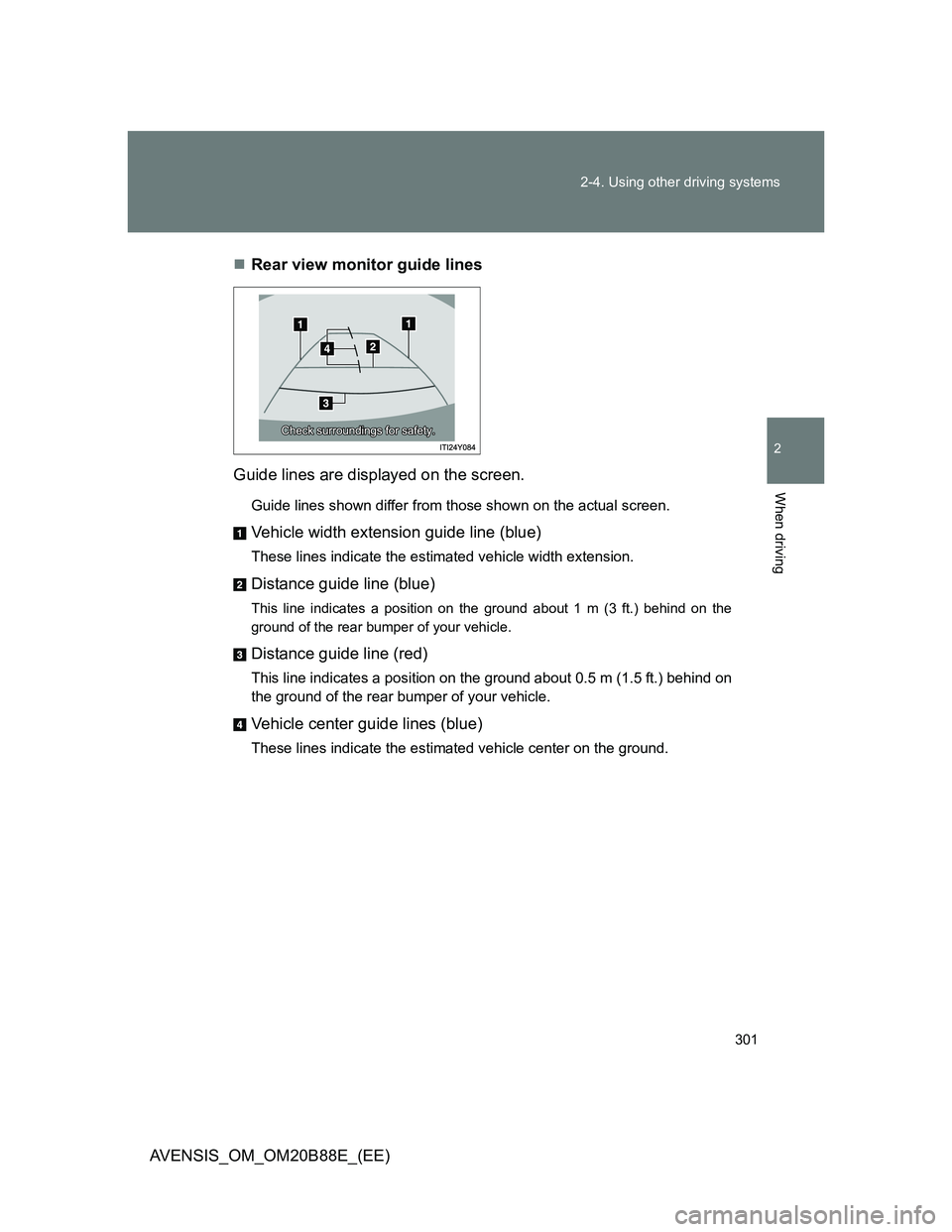
301 2-4. Using other driving systems
2
When driving
AVENSIS_OM_OM20B88E_(EE)Rear view monitor guide lines
Guide lines are displayed on the screen.
Guide lines shown differ from those shown on the actual screen.
Vehicle width extension guide line (blue)
These lines indicate the estimated vehicle width extension.
Distance guide line (blue)
This line indicates a position on the ground about 1 m (3 ft.) behind on the
ground of the rear bumper of your vehicle.
Distance guide line (red)
This line indicates a position on the ground about 0.5 m (1.5 ft.) behind on
the ground of the rear bumper of your vehicle.
Vehicle center guide lines (blue)
These lines indicate the estimated vehicle center on the ground.
Page 302 of 776
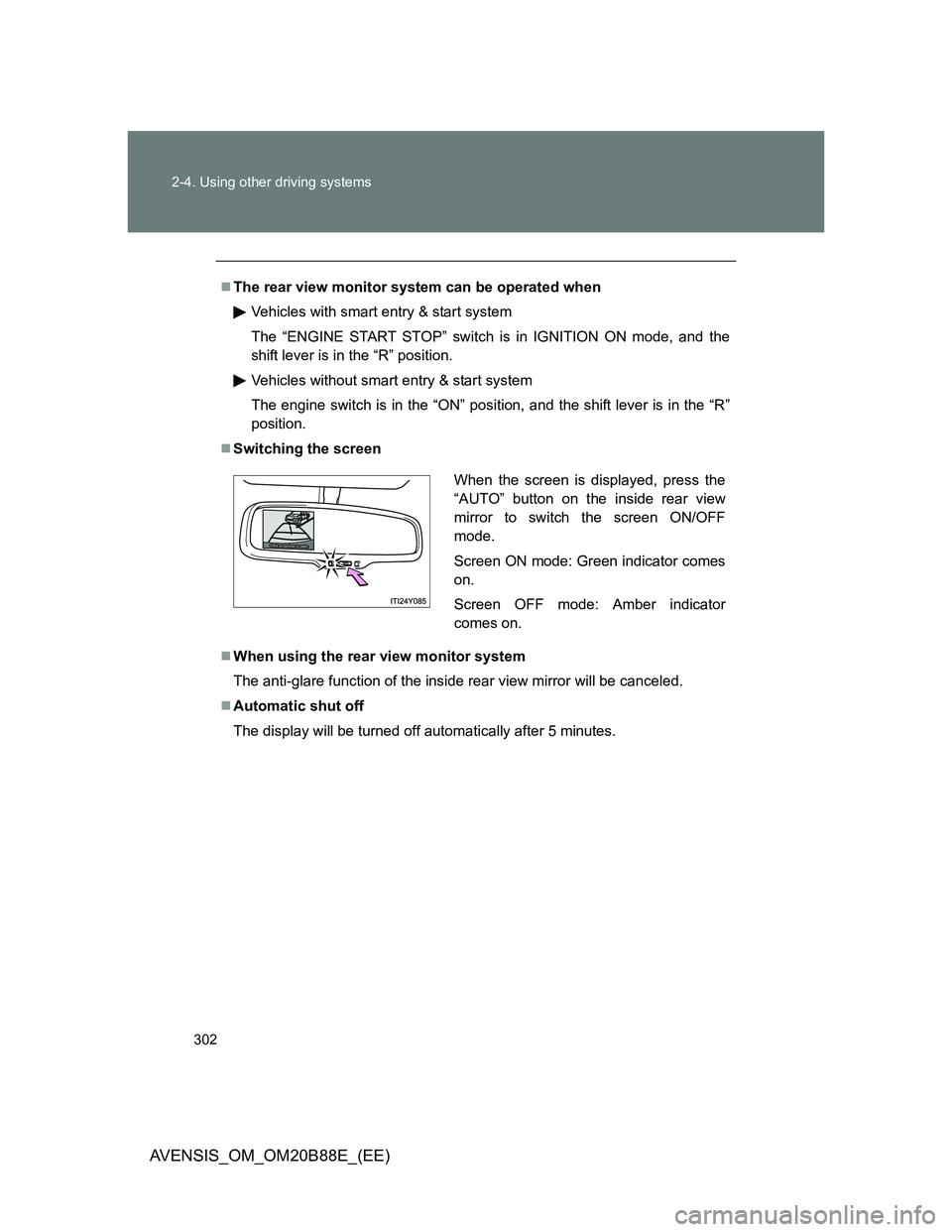
302 2-4. Using other driving systems
AVENSIS_OM_OM20B88E_(EE)
The rear view monitor system can be operated when
Vehicles with smart entry & start system
The “ENGINE START STOP” switch is in IGNITION ON mode, and the
shift lever is in the “R” position.
Vehicles without smart entry & start system
The engine switch is in the “ON” position, and the shift lever is in the “R”
position.
Switching the screen
When using the rear view monitor system
The anti-glare function of the inside rear view mirror will be canceled.
Automatic shut off
The display will be turned off automatically after 5 minutes.
When the screen is displayed, press the
“AUTO” button on the inside rear view
mirror to switch the screen ON/OFF
mode.
Screen ON mode: Green indicator comes
on.
Screen OFF mode: Amber indicator
comes on.
Page 303 of 776
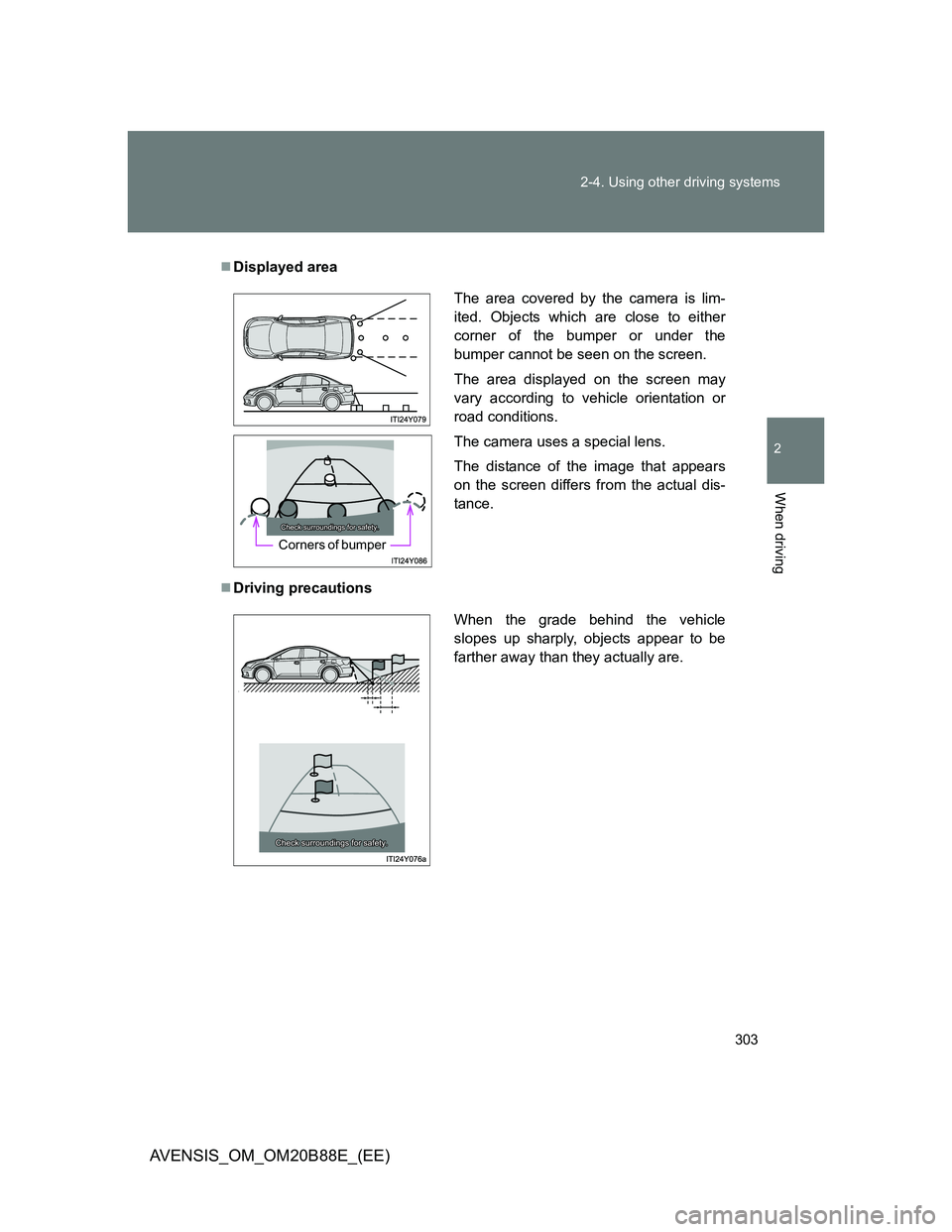
303 2-4. Using other driving systems
2
When driving
AVENSIS_OM_OM20B88E_(EE)
Displayed area
Driving precautions
The area covered by the camera is lim-
ited. Objects which are close to either
corner of the bumper or under the
bumper cannot be seen on the screen.
The area displayed on the screen may
vary according to vehicle orientation or
road conditions.
The camera uses a special lens.
The distance of the image that appears
on the screen differs from the actual dis-
tance.
Corners of bumper
When the grade behind the vehicle
slopes up sharply, objects appear to be
farther away than they actually are.
Page 304 of 776
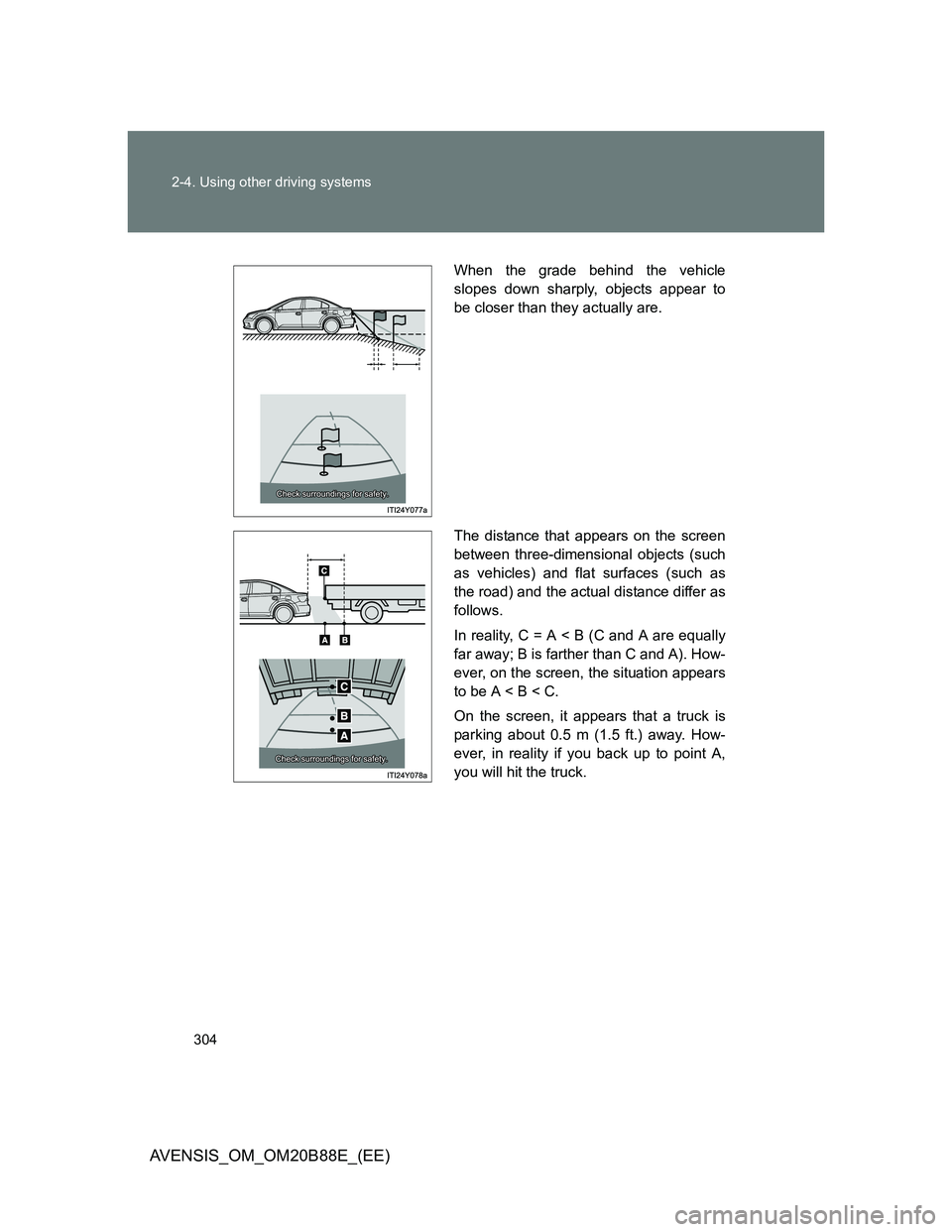
304 2-4. Using other driving systems
AVENSIS_OM_OM20B88E_(EE)
When the grade behind the vehicle
slopes down sharply, objects appear to
be closer than they actually are.
The distance that appears on the screen
between three-dimensional objects (such
as vehicles) and flat surfaces (such as
the road) and the actual distance differ as
follows.
In reality, C = A < B (C and A are equally
far away; B is farther than C and A). How-
ever, on the screen, the situation appears
to be A < B < C.
On the screen, it appears that a truck is
parking about 0.5 m (1.5 ft.) away. How-
ever, in reality if you back up to point A,
you will hit the truck.
Page 305 of 776
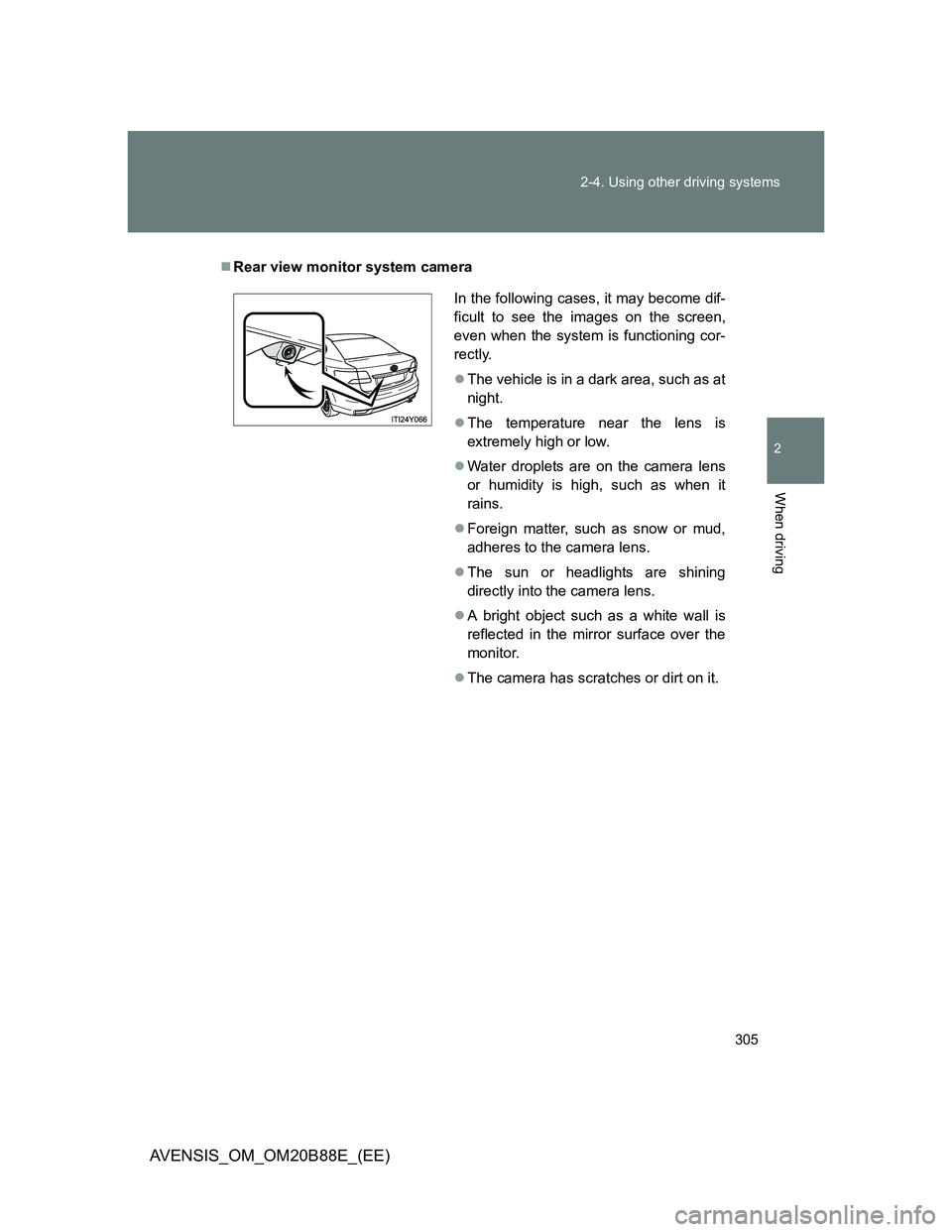
305 2-4. Using other driving systems
2
When driving
AVENSIS_OM_OM20B88E_(EE)
Rear view monitor system camera
In the following cases, it may become dif-
ficult to see the images on the screen,
even when the system is functioning cor-
rectly.
The vehicle is in a dark area, such as at
night.
The temperature near the lens is
extremely high or low.
Water droplets are on the camera lens
or humidity is high, such as when it
rains.
Foreign matter, such as snow or mud,
adheres to the camera lens.
The sun or headlights are shining
directly into the camera lens.
A bright object such as a white wall is
reflected in the mirror surface over the
monitor.
The camera has scratches or dirt on it.
Page 306 of 776
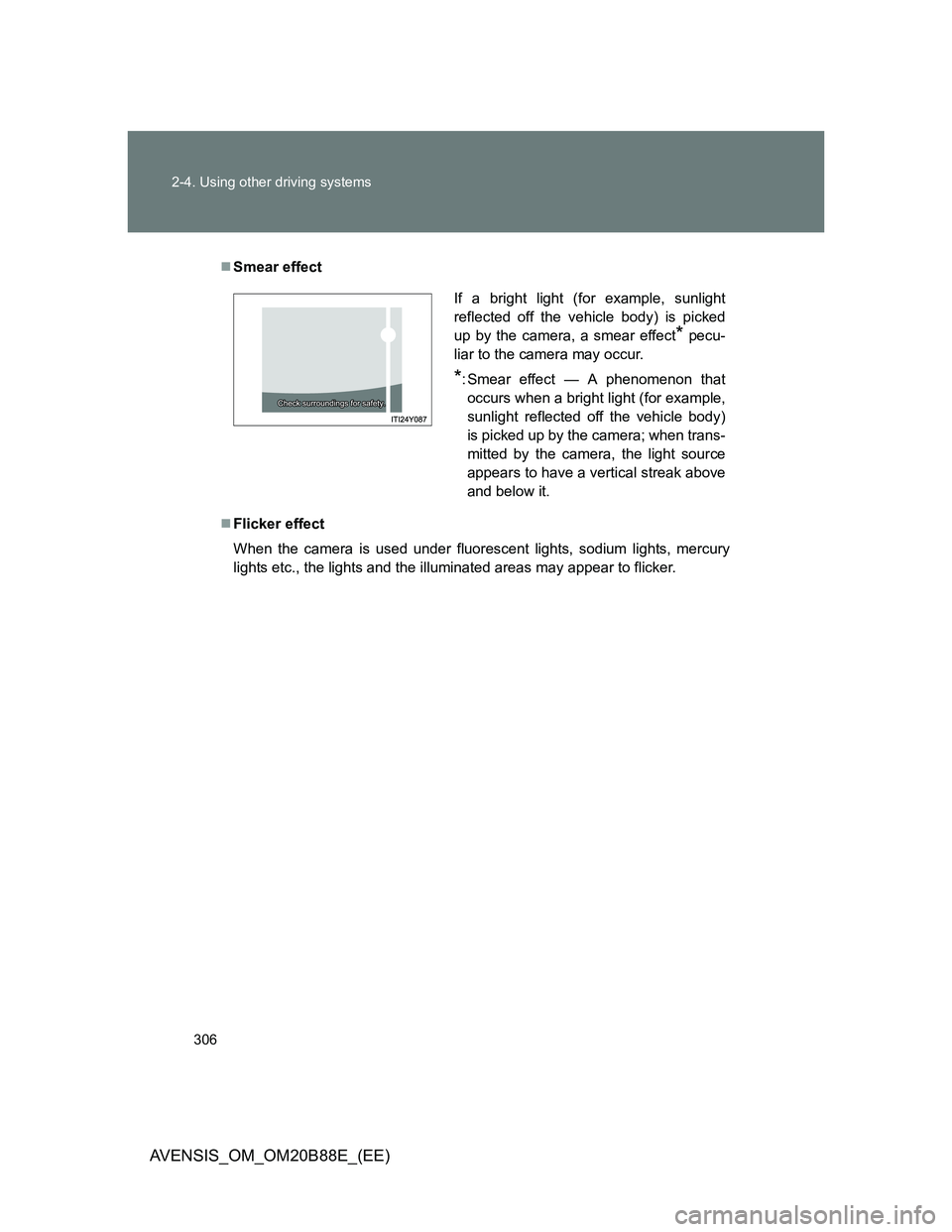
306 2-4. Using other driving systems
AVENSIS_OM_OM20B88E_(EE)
Smear effect
Flicker effect
When the camera is used under fluorescent lights, sodium lights, mercury
lights etc., the lights and the illuminated areas may appear to flicker.
If a bright light (for example, sunlight
reflected off the vehicle body) is picked
up by the camera, a smear effect
* pecu-
liar to the camera may occur.
*: Smear effect — A phenomenon that
occurs when a bright light (for example,
sunlight reflected off the vehicle body)
is picked up by the camera; when trans-
mitted by the camera, the light source
appears to have a vertical streak above
and below it.
Page 307 of 776
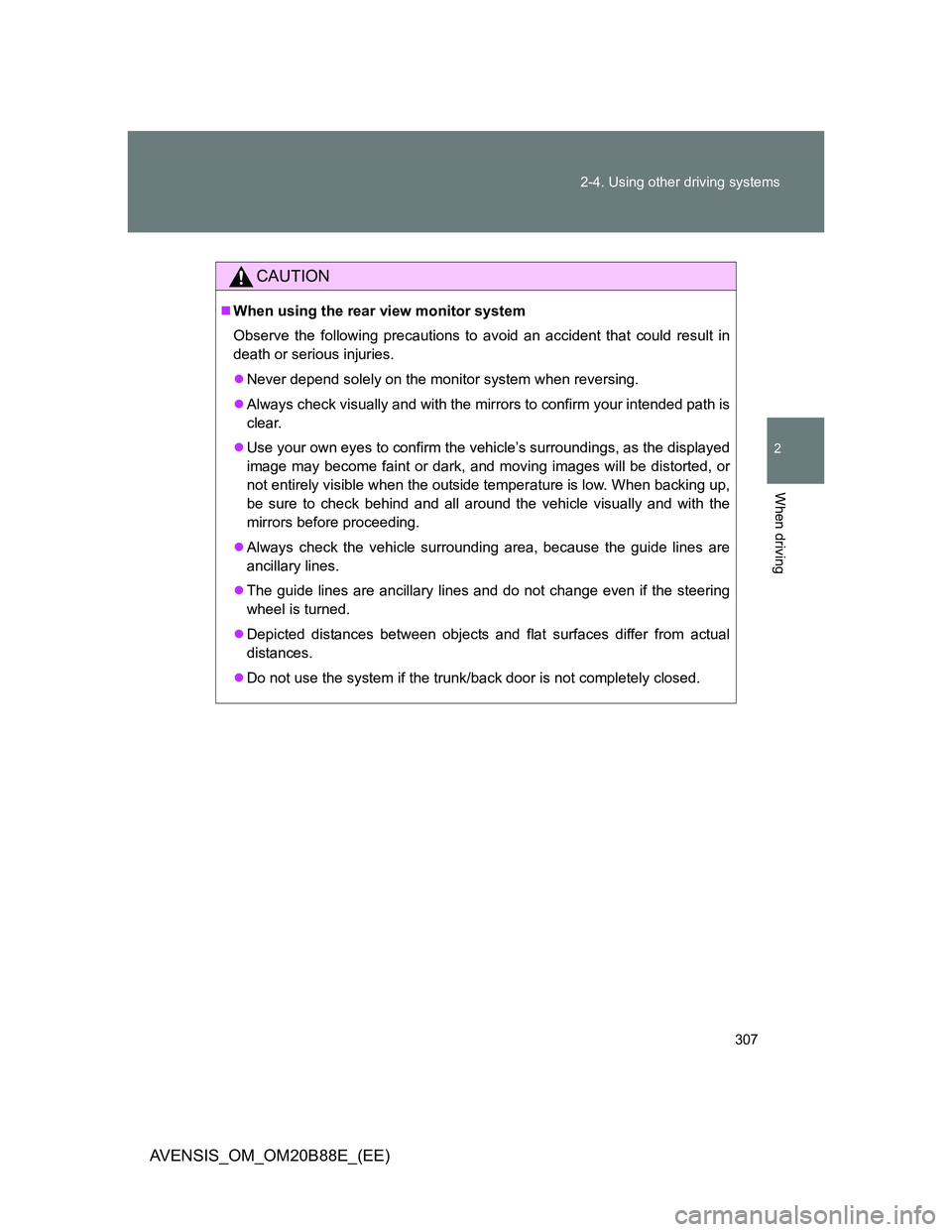
307 2-4. Using other driving systems
2
When driving
AVENSIS_OM_OM20B88E_(EE)
CAUTION
When using the rear view monitor system
Observe the following precautions to avoid an accident that could result in
death or serious injuries.
Never depend solely on the monitor system when reversing.
Always check visually and with the mirrors to confirm your intended path is
clear.
Use your own eyes to confirm the vehicle’s surroundings, as the displayed
image may become faint or dark, and moving images will be distorted, or
not entirely visible when the outside temperature is low. When backing up,
be sure to check behind and all around the vehicle visually and with the
mirrors before proceeding.
Always check the vehicle surrounding area, because the guide lines are
ancillary lines.
The guide lines are ancillary lines and do not change even if the steering
wheel is turned.
Depicted distances between objects and flat surfaces differ from actual
distances.
Do not use the system if the trunk/back door is not completely closed.
Page 308 of 776
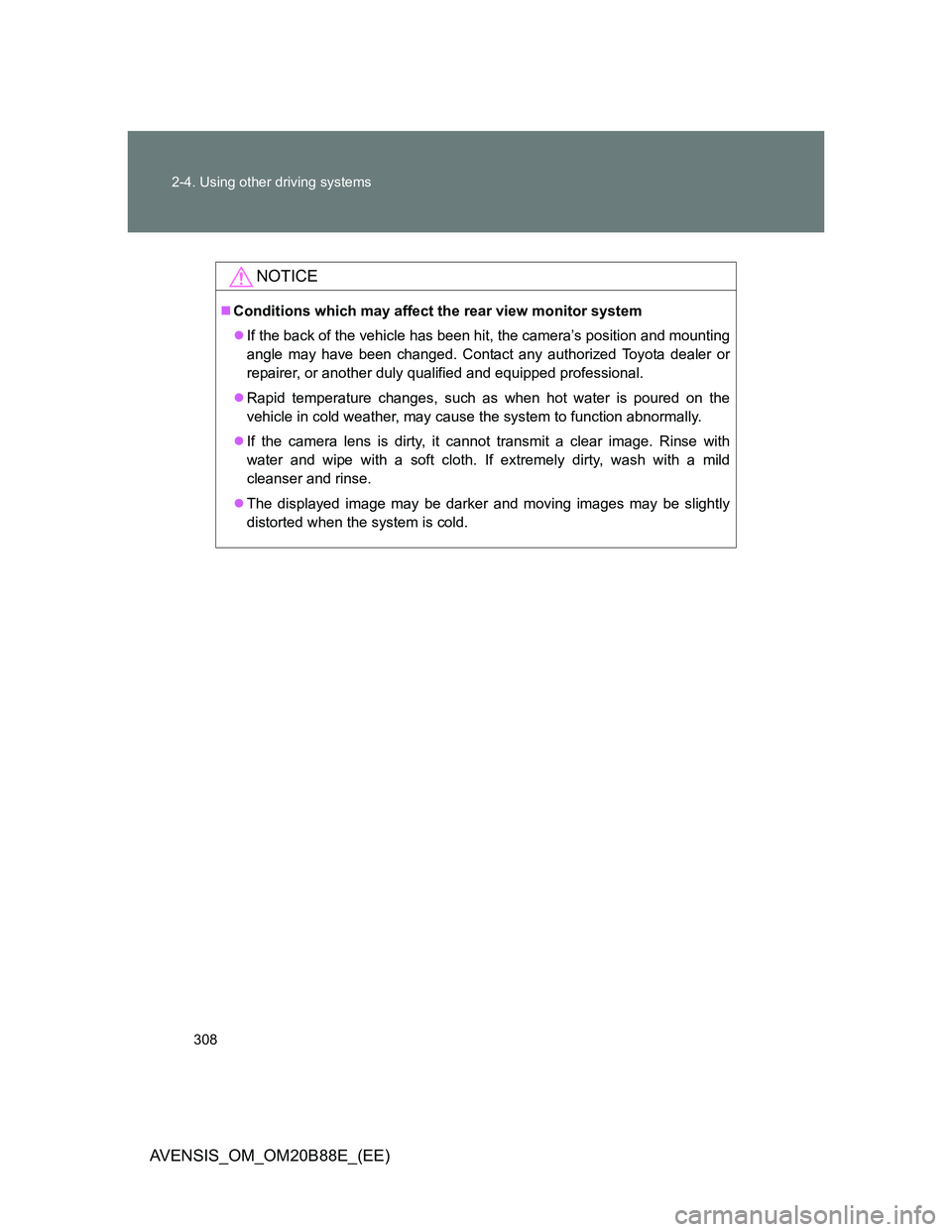
308 2-4. Using other driving systems
AVENSIS_OM_OM20B88E_(EE)
NOTICE
Conditions which may affect the rear view monitor system
If the back of the vehicle has been hit, the camera’s position and mounting
angle may have been changed. Contact any authorized Toyota dealer or
repairer, or another duly qualified and equipped professional.
Rapid temperature changes, such as when hot water is poured on the
vehicle in cold weather, may cause the system to function abnormally.
If the camera lens is dirty, it cannot transmit a clear image. Rinse with
water and wipe with a soft cloth. If extremely dirty, wash with a mild
cleanser and rinse.
The displayed image may be darker and moving images may be slightly
distorted when the system is cold.
Page 309 of 776
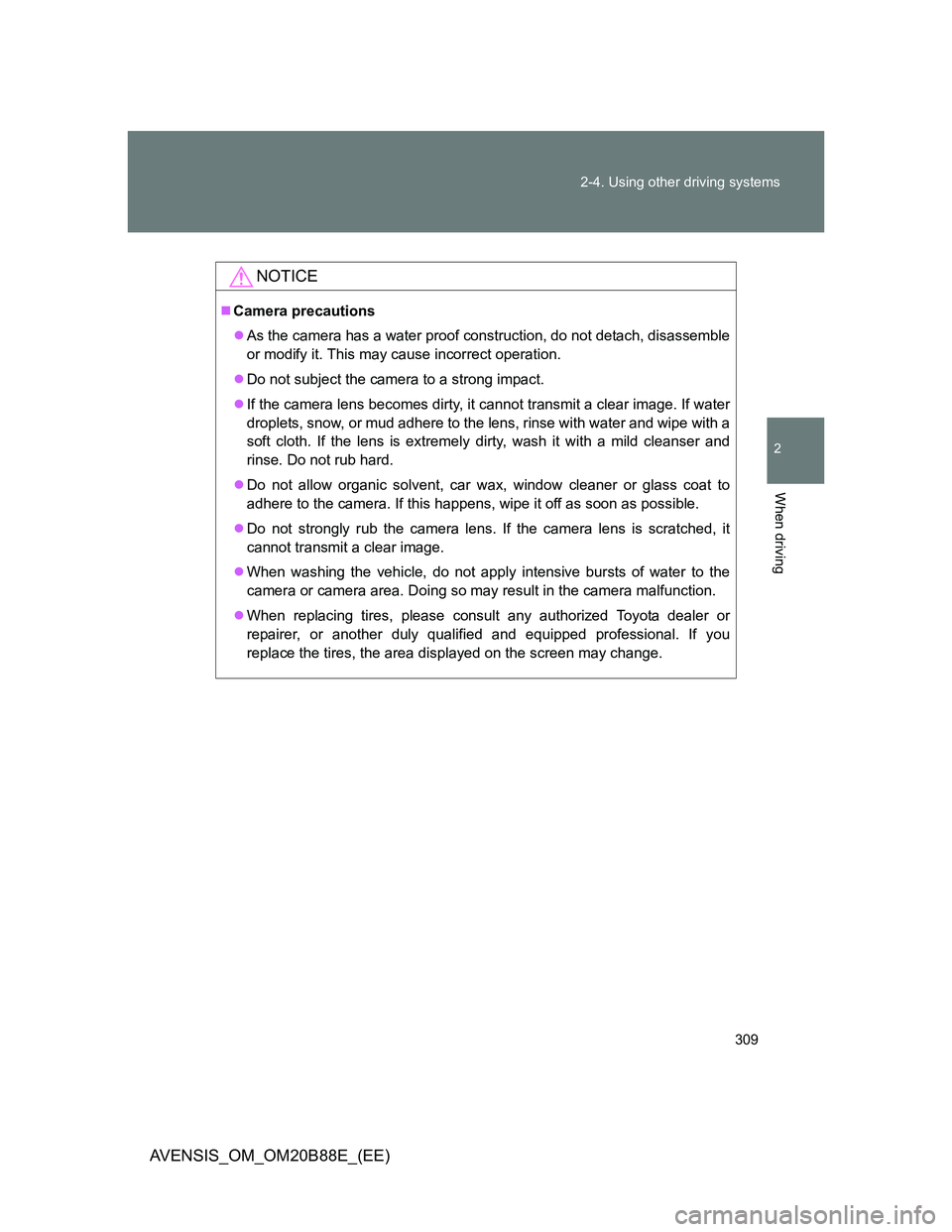
309 2-4. Using other driving systems
2
When driving
AVENSIS_OM_OM20B88E_(EE)
NOTICE
Camera precautions
As the camera has a water proof construction, do not detach, disassemble
or modify it. This may cause incorrect operation.
Do not subject the camera to a strong impact.
If the camera lens becomes dirty, it cannot transmit a clear image. If water
droplets, snow, or mud adhere to the lens, rinse with water and wipe with a
soft cloth. If the lens is extremely dirty, wash it with a mild cleanser and
rinse. Do not rub hard.
Do not allow organic solvent, car wax, window cleaner or glass coat to
adhere to the camera. If this happens, wipe it off as soon as possible.
Do not strongly rub the camera lens. If the camera lens is scratched, it
cannot transmit a clear image.
When washing the vehicle, do not apply intensive bursts of water to the
camera or camera area. Doing so may result in the camera malfunction.
When replacing tires, please consult any authorized Toyota dealer or
repairer, or another duly qualified and equipped professional. If you
replace the tires, the area displayed on the screen may change.
Page 310 of 776
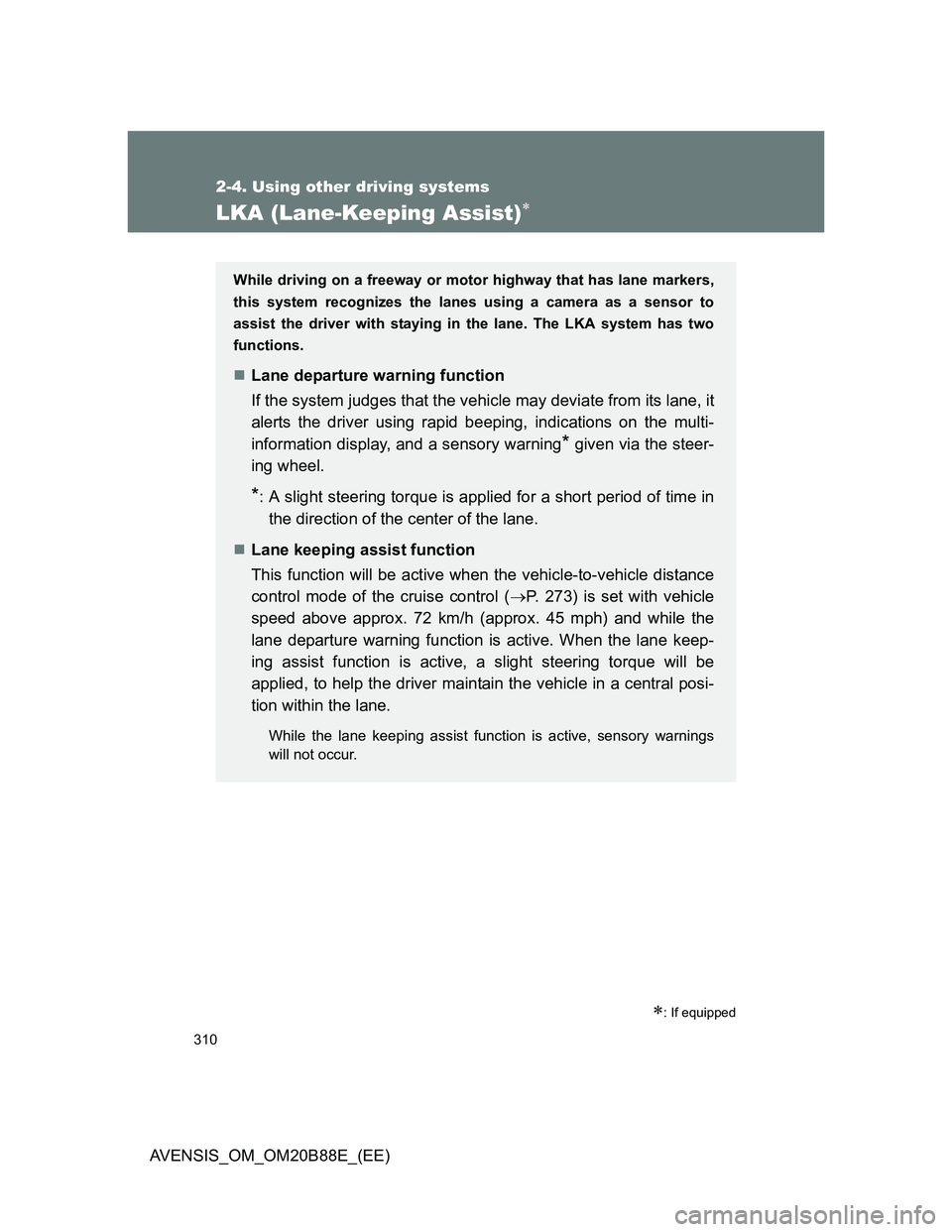
310
2-4. Using other driving systems
AVENSIS_OM_OM20B88E_(EE)
LKA (Lane-Keeping Assist)
: If equipped
While driving on a freeway or motor highway that has lane markers,
this system recognizes the lanes using a camera as a sensor to
assist the driver with staying in the lane. The LKA system has two
functions.
Lane departure warning function
If the system judges that the vehicle may deviate from its lane, it
alerts the driver using rapid beeping, indications on the multi-
information display, and a sensory warning
* given via the steer-
ing wheel.
*: A slight steering torque is applied for a short period of time in
the direction of the center of the lane.
Lane keeping assist function
This function will be active when the vehicle-to-vehicle distance
control mode of the cruise control (P. 273) is set with vehicle
speed above approx. 72 km/h (approx. 45 mph) and while the
lane departure warning function is active. When the lane keep-
ing assist function is active, a slight steering torque will be
applied, to help the driver maintain the vehicle in a central posi-
tion within the lane.
While the lane keeping assist function is active, sensory warnings
will not occur.